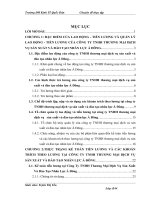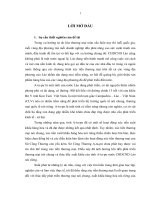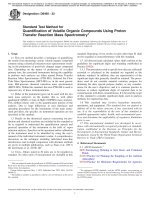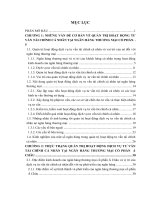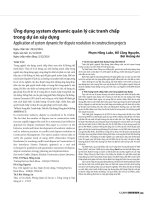Solution manual of environmental chemistry a global perspective 4th s ch10
Bạn đang xem bản rút gọn của tài liệu. Xem và tải ngay bản đầy đủ của tài liệu tại đây (321.01 KB, 14 trang )
Solutions: Environmental Chemistry - a global perspective 4th Edition
Chapter 10
Distribution of species in aquatic systems
PROBLEMS/SOLUTIONS
1.
Consider the case of sulfurous acid (H2SO3), which is quantitatively formed when sulfur dioxide gas dissolves
in water.
(a) Without calculation, but referring to the appropriate dissociation constants, carefully sketch a single
variable species distribution diagram (versus pH) for this acid in water.
(b) Calculate accurately the concentration of all the sulfite species at pH = 7.0.
Solution
Part a)
SO2 (g)
(H2O)
↔ SO2 (aq) + H2O (l) ↔
H2SO3 (aq)
H2SO3 (aq) ↔ HSO3- + H+ Ka1
HSO3- (aq) ↔ SO32- + H+ Ka2
Look up the Ka values for H2SO3
(Appendix B.4)
Ka1 = 1.72 x 10-2
Ka2 = 6.43 x 10-8
Convert to pKa
(p = -log)
pKa1 = 1.76
pKa2 = 7.19
Recall that pH = pKa when there is an equal amount of two adjacent species (conjugated acid/base pair).
Henderson-Hasselbach equation ( pH = pKa + log [conjugate base]/[acid] )
So when [H2SO3] = [HSO3-] in the same solution the pH is 1.76 and α is 0.5, and when [HSO3-] = [SO32-] the pH
is 7.19 and α is 0.5. At very low pH, the fully protonated species will dominate and at very high pH the fully
deprotonated form i.e., SO32- will dominate. The intermediate species, hydrogen sulfite, HSO3-, will be dominant at
pH = ½ (pKa1 + pKa2). Fill in the lines by joining the identified points to produce an approximate species distribution
diagram.
81
Solutions: Environmental Chemistry - a global perspective 4th Edition
Chapter 10
Distribution of species in aqueous systems
Sketch the distribution diagram where: ‘y’ axis is α & ‘x’ axis is pH.
1
H2SO3
1.76
7.19
0.5
SO32-
HSO3-
0
1
3
5
7
9
11
13
pH
Note that the pKa values of these species are sufficiently 'far apart' that they can be treated in this simple way.
Part b)
The amount of SO2 (g) in an unpolluted atmosphere is given in Table 5.2 as the range 0.1 to 0.5 ppbv. Assume the
concentration is 0.3 ppbv for this calculation.
Henry’s Law constant for SO2 (g) is 1.2 x 10-5 mol L-1 Pa-1 (Table 11.1)
0.3 ppbv = 0.00000003% = 3.0 x 10-10 atm = 3.04 x 10-5 Pa
[SO2 (aq)] = 1.2 x 10-5 mol L-1 Pa-1 x 3.04 x 10-5 Pa = 3.65 x 10-10 mol L-1
Assume all SO2 aq is converted to H2SO3 (aq).
Ka1
[1.0 x 10-7][HSO3-]
= ---------------------- = 1.72 x 10-2
[3.65 x 10-10]
[HSO3-] = 6.3 x 10-5 mol L-1
Ka2
[1.0 x 10-7][SO32-]
= --------------------- = 6.43 x 10-8
[6.3 x 10-5]
[SO32-] = 4.0 x 10-5 mol L-1
The total amount of sulfite species present at pH 7.0 is
82
Solutions: Environmental Chemistry - a global perspective 4th Edition
Chapter 10
Distribution of species in aquatic systems
3.65 x 10-10 mol L-1 + 6.3 x 10-5 mol L-1 + 4.0 x 10-5 mol L-1 = 1.0 x 10-4 mol L-1
[H2SO3]
[HSO3-]
[SO32-]
αHSO3
-
αH2SO3
6.3 x 10-5
= ---------------- = 0.63
1.0 x 10-4
αSO3
2-
4.0 x 10-5
= ----------------- = 0.40
1.0 x 10-4
3.64 x 10-10
= ----------------- = 3.6 x 10-6 ~ 0.00
1.0 x 10-4
total α = 0.63 + 0.40 + 0.00 ~ 1.00 (in reasonable agreement with hand sketched species distribution diagram
from part a)
2.
Set up a spreadsheet calculation to examine the acid-base speciation of arsenate over the pH range 0 to14. What
is the % distribution of species in acid mine drainage whose pH is 4.9?
Solution
Refer to Appendix B.4 for the dissociation constants for arsenic acid.
H3AsO4 Ka1 = 5.8 x10-3 pKa1 = 2.24
H2AsO4- Ka1 = 1.1 x10-7 pKa1 = 6.96
HAsO42- Ka1 = 3.2 x10-12 pKa1 = 11.50
Following the set of Equations (10.12-10.15) set up for phosphate, substitute in the arsenate species. Refer also to
the instructions given near the end of Section 10.1 on Equilibrium calculations done on spreadsheets, to generate the
diagram seen above. Each of the three pKa values agree well (visually) with the 0.5 alpha points of intersection for
each of these points.
At pH 4.9, without calculation, but as viewed on the distribution diagram ~100% of the species will exist as H2AsO4.
83
Solutions: Environmental Chemistry - a global perspective 4th Edition
Chapter 10
3.
Distribution of species in aqueous systems
Use standard thermodynamic relations and assumptions to show that
n( pE º ) log Keq
Solution
(Refer to Section 10.2)
Consider the half-reaction
Fe3+ (aq) + e-
Fe2+ (aq)
aFe2
K eq
aFe3 ae
1
K eq aFe3
=
a
aFelogs
2 of both sides, we have
Using the definition of pE (pE = e– log {e }) and taking
-
pE = – log ae_ = log Keq + log (aFe3+ / aFe2+)
We also have
ΔGº = – 2.303 RT log Keq
= – nFEº
Note that n has the usual electrochemical meaning, i.e. the number of electrons transferred in the half-reaction.
Therefore, at 298 K and using R = 8.315 J mol-1 K-1 and F = 96 485 C mol-1, we have
logK eq
In this case, n = 1
n F E
n E
=
=
2.303 RT
0.0591
log K eq
E
=
0.0591
aFe 3
E
pE =
+ log
0.0591
aFe 2
84
Solutions: Environmental Chemistry - a global perspective 4th Edition
Chapter 10
Distribution of species in aquatic systems
aFe3+ = aFe2+ = 1
Under standard conditions
aFe3+
log ------ = 0
aFe2+
and
E
pE = pE =
0.0591
For non standard conditions
pE = pE + log
aFe3
a
2
Fe
When the standard pEo value and the actual activities (usually approximated by concentrations)
of Fe3+ and Fe2+ are
substituted into this equation, the pE of a particular environmental system can be calculated.
In the general case, for a reaction
aA + ne-
bB
where A and B are the oxidized and reduced forms of a redox couple respectively, the reaction quotient (Q) is defined
as
(aB)b
Q = ------------(aA)a
The reaction quotient takes the form of an equilibrium constant, but uses activities (or, as an approximation,
concentrations) that obtain under any conditions, not just those at equilibrium. The general form is then
pE = pE When pE = 0 and under equilibrium conditions (i.e. Keq) then
1
log Q
n
1
pEº = ----- log Keq
n
or, this can be expressed as:
n(pEº) = log Keq
85
Solutions: Environmental Chemistry - a global perspective 4th Edition
Chapter 10
4.
Distribution of species in aqueous systems
Consider the equilibrium of an aqueous solution containing solid manganese dioxide as indicated in the
following equation.
How are the solution’s pH and pE affected by the individual addition of each of the following:
MnO2 , CO2 (g), Fe2 (aq), and CaCO3?
Solution
MnO4- (aq) + 4H3O+ (aq) + 3eAddition of:
5.
MnO2 (s) + 6H2O (l)
MnO2 (s)
- no effect on pH or pE
CO2 (g)
- decrease in pH and increase in pE
Fe2+ (aq)
- decrease in pE and increase in pH
CaCO3 (s)
- increase in pH and decrease in pE
A potential measurement in a paddy field yields a reading of –278 mV versus the saturated calomel reference
electrode. What is the pE value for this soil?
Solution
E = – 278 mV vs. SCE
E vs. NHE = – 0.278 V + 0.242 V = – 0.036 V
(correction factor for SCE vs. NHE)
– 0.036 V
pE = ------------ = – 0.61
0.0591 V
The pE value for the paddy field soil is – 0.61.
6.
Iron toxicity has occasionally been observed in rice plants grown in lowlands (submerged soils). Use the simple
pE / pH diagram for iron in Fig. 10.P.1 to explain how this can happen.
86
Solutions: Environmental Chemistry - a global perspective 4th Edition
Chapter 10
Distribution of species in aquatic systems
Fig. 10.P.1 The pE / pH diagram for iron.
Solution
The pH of a submerged soil is typically acidic and has a low (0 to - 5) pE value. A soil containing large amounts of
any of these following solid forms of iron, Fe(OH) 3, Fe(CO3) or Fe2O3 is likely to have Fe2+ (aq) present in
relatively high concentration. Iron(II) is stable under these conditions of low pE and slight acidity. This could lead
to a situation of iron toxicity.
7.
Iron(III) hydroxide can act as an oxidizing agent as indicated by the half-reaction
(a) Assuming pH = 7 and otherwise standard conditions, can the oxidation of
NH 4 to NO3 be effected by
this reaction in the hydrosphere?
(b) Could the reaction bring about the oxidation of HS– to
conditions)?
Solution
SO 24 at a pH of 9 (again, under otherwise standard
Part a) There are several ways this question can be answered. One is to compare the pE values under the specified
conditions. To do this, we need to obtain pEo values for each reaction. The necessary values for the nitrogen and
sulfur reactions are given in Appendix B.5. The value for the iron reaction can be calculated from the tabulated data,
as shown in Section 10.2.
NO3- + 10H+ + 8e- ↔ NH4+ + 3H2O
pEº = 14.9
Eº = 0.882 V
The calculated pE for a pH of 7 (assuming standard conditions for all other species) is
87
Solutions: Environmental Chemistry - a global perspective 4th Edition
Chapter 10
Distribution of species in aqueous systems
1
[NH4+]
pE = pEº - ----- log ---------------------8
[NO3-][1x10-7]10
pE = 14.9 - 8.75 = 6.2
The pE for the iron system, at pH 7, is calculated based on the following reaction:
Fe(OH)3 (s) + 3H3O+ (aq) + e- ↔ Fe2+ (aq) + 6H2O (l) Eº = 1.005 V
pE = pEº - log ([Fe2+]/[H+]3)
pE = 17 - log (1/(1x10-7) 3) = - 4
When all the components of the two reactions are present together, the reaction whose pE value is more positive is
the reaction that will tend to go from left to right (forward). Therefore, under the conditions specified, nitrate would
be reduced and iron(II) would be oxidized.
A second way of solving this problem is to combine the two reactions in a way that indicates iron(III) hydroxide
oxidizing ammonium ion to nitrate, as shown.
8Fe(OH)3 (s) + 24H3O+ (aq) + 8e- ↔ 8Fe2+ (aq) + 48H2O (l)
NH4+ (aq) + 13H2O ↔ NO3- (aq) + 10H3O+ (aq) + 8e---------------------------------------------------------------------------------------------------------8Fe(OH)3 (s) + 14H3O+ (aq) + NH4+ (aq) ↔ 8Fe2+ (aq) + 35H2O (l) + NO3- (aq)
If this processes will occur at pH 7, the overall pE value calculated from the two half-reactions should be positive
indicating a spontaneous process.
Using Equation 10.48
pE = pEo - 1/n log Q
pE = 17.0 - 14.9 - 1/8 log 1/(10-7)14
= -10.2
The negative sign here indicates that the reaction is not spontaneous as written and would tend to proceed in the
reverse direction. That is, the Fe(OH)3 will not act as the oxidizing agent, but any NO3- would instead tend to
generate NH4+ and Fe2+ will precipitate to form Fe(OH)3.
Part b)
We will solve this problem, using only the first method shown above.
SO42- + 9H+ + 8e- ↔ HS- + 4H2O
pEº = 4.20
Eº = 0.248 V
88
Solutions: Environmental Chemistry - a global perspective 4th Edition
Chapter 10
Distribution of species in aquatic systems
pE = 4.20 – 1/8 log(1/1x10-9)9
pE = 4.204 – 10.125
pE = – 5.9
(see Figure 10.5)
In this case, the pE value of the reaction is more negative than that for the iron reaction (–4). Therefore, iron(III)
hydroxide is a sufficiently good oxidizing agent to oxidize the HS - species to form sulfate.
Note that it is possible to calculate the equilibrium constant for the reactions above, and this will also confirm the
conclusions reached by the methods shown.
8.
Consider the following aqueous uranium species
Calculate the UOH3+ concentration under typical pE and pH conditions for acid mine drainage waters assuming
CU = 1 × 10–5 mol L–1.
ΔGfº values / kJ mol–1 are:
UO22
– 989.5
UOH3+
– 810.0
U
4+
– 579.3
Solution
Typical pE and pH conditions for acid mine drainage are pE = 16 and pH = 3 (see Figure 10.6). Assume a
temperature of 298 K.
The reactions being considered are:
1)
2)
UO22+ (aq) + 4H3O+ (aq) + 2e- ↔ U4+ (aq) + 6H2O (l) (+ 0.334 V)
UO22+ (aq) + 3H3O+ (aq) + 2e- ↔ UOH3+ (aq) + 4H2O (l)
And we have been given the equation:
3)
Cu = CU4+ + CUO22+ + CUOH3+ = 1 x 10-5 mol L-1
Solve in terms of CUO22+ for
CU4+ and CUOH3+
From Reaction 1) shown above,
ΔGº = (6(–237.18) + (–579.3)) – (4(–237.18 ) + –989.5)) = –64.2 kJ mol-1
pEº = – ΔGº / 2.303 nRT = 5.62
89
Solutions: Environmental Chemistry - a global perspective 4th Edition
Chapter 10
Distribution of species in aqueous systems
and using pE = 16 and pH = 3
1
[U4+]
pE = pEº – ----- log --------------------2
[UO22+] [H3O+]4
1
[U4+]
16 = 5.62 – ----- log --------------------2
[UO22+] [10-3]4
[U4+]
----------- = 1.74x10-33
[UO22+]
Calculate ΔGº from given values of ΔGfº for Reaction 2) shown earlier,
ΔGº = (–810.0) + 4(–237.18) – (3(–237.18 ) + (–989.5)) = –57.7 kJ mol-1
pEº = – ΔGº / 2.303 nRT = 5.05
and using pE = 16 and pH = 3
1
[UOH3+]
pE = pEº – ----- log --------------------2
[UO22+] [H3O+]3
1
[UOH3+]
16 = 5.05 – ----- log --------------------2
[UO22+] [10-3]3
[UOH3+]
-------------- = 1.26x10-31
[UO22+]
[UOH3+] = 1.26x10-31 [UO22+]
[U4+] = 1.74x10-33 [UO22+]
Substitute known relationships into Equation 3 (in terms of UO22+) and solve.
Equation 3)
CU4+
+
CUO22+
+ CUOH3+ = 1 x 10-5 mol L-1
1.74x10-33 [UO22+] + CUO22+ + 1.26x10-31 [UO22+] = 1 x 10-5 mol L-1
(0 + 1 + 0)[UO22+] = 1 x 10-5 mol L-1
[UO22+] = 1.0 x 10-5 mol L-1
The uranium species will end up entirely as the UO22+ under the conditions of acid mine drainage.
The UOH3+ concentration will be essentially zero. (It is calculated to be 1.26x10-36 mol L-1)
90
Solutions: Environmental Chemistry - a global perspective 4th Edition
Chapter 10
9.
Distribution of species in aquatic systems
Figure 10.P.2 is a partially completed pE / pH diagram for arsenic species.
Fig. 10.P.2 The pE / pH diagram for some arsenic species.
(a) Calculate the equation for the line (shown) for the boundary
H 2 AsO4 (aq) / H3AsO3 (aq).
(b) Calculate equations for the lines (not shown) for the boundaries H 3AsO4 /
H3AsO3.
H 2 AsO4 and H3AsO4 /
Assume a temperature of 25ºC. For boundaries use Cspecies = 1 × 10 –4 mol L–1.
(c) Comment on predicted As species in seawater and acid mine drainage. In both situations assume that the
solution is well aerated.
ΔGfº values / kJ mol–1 are:
H3AsO4
– 769.3
H 2 AsO4
– 748.8
H3AsO3
– 640.0
H 2 AsO3
– 587.7
H2O
– 237.2
Solution
Part a) The reaction being considered is:
H2AsO4 - (aq) + 2e- + 3H+ (aq)
H3AsO3 (aq) + H2O (l)
ΔGº = (– 640.0 + –237.2) – (–748.8 + 0 + 0) = – 128.4 kJ
91
Solutions: Environmental Chemistry - a global perspective 4th Edition
Chapter 10
Distribution of species in aqueous systems
128 400 J
pEº = ------------------ = 11.3
11 413.07
1
[H3AsO3]
pE = pEº – ---- log ---------------------2
[H2AsO4-][H+]3
Using the boundary condition of 1 x 10-4 mol L-1
3
1
pE = 11.3 – ----- log -----2
[H+]
Part b) Consider
H3AsO4 / H2AsO4-
H3AsO4 (aq)
pE = 11.3 – 1.5pH
boundary – no redox.
H2AsO4 - (aq) + H+ (aq)
ΔGº = (–748.8 + 0) – (–769.3) = 20.5 kJ
– 20 500 J
log K = ------------------ = – 3.6
5706.53
[H2AsO4-][H+]
K = -------------------[H3AsO4]
K = [H+]
at the boundary [H3AsO4] = [H2AsO4-] = 10-4 M
log K = log [H+] = – 3.6
pH = 3.6 is the boundary condition (depends only on pH).
Part b) Consider
H3AsO4 / H3AsO3 boundary – redox condition
2 electron process
H3AsO4 (aq) + 2 e- + 2 H+
H3AsO3 (aq) + H2O
ΔGº = – 107.7 kJ
107 700 J
pEº = ---------------- = 9.44
11 413.07
92
Solutions: Environmental Chemistry - a global perspective 4th Edition
Chapter 10
Distribution of species in aquatic systems
1
1
pE = 9.44 – ----- log ----2
[H+]2
pE = 9.44 – pH
Part c) The type of arsenic species that would be found in acid mine drainage would be the higher oxidation state
(As-V) and it is likely to be fully protonated (H3AsO4). The seawater species will also be the higher oxidation state,
but likely deprotonated (H2AsO4 -).
10. As we have mentioned in the text, Eh is sometimes used in place of pE.
(a) Calculate the lower and upper stability boundary lines for water using Eh.
(b) Show that if you divide each line determined in part (a) by 0.0591 that you end up with the
equations shown in the text (pE = ̶ pH and pE = 20.80 – pH, for the lower and upper
boundaries respectively).
(c) Using Fig 10.P.1, the iron pE/pH diagram in problem 6, convert the scale of pE shown to
Eh. What must you do?
Solution
Part a)
2H2O (l) + 2e-
H2 (g) + 2 OH- (aq) E° = – 0.828V (the lower boundary)
Use the Nernst equation:
Eh = E° – (0.0591/n) log(PH2 (g) x [OH-]2 / 1)
n = 2, PH2 (g) = 1.00 atm, (note: pOH + pH = 14, or pOH = 14 – pH)
Eh = – 0.828V – (0.0591/2) log(1.00 x [OH-]2 / 1)
The two ‘2’s cancel (one inside log term (exponent) and the two outside log term (denominator))
Eh = – 0.828V – (0.0591/1)log(1.00 x [OH-] / 1)
Eh = – 0.828V – (0.0591)log[OH-]
Eh = – 0.828V + (0.0591) pOH
(note the change in sign)
Eh = – 0.828V + (0.0591)(14 – pH)
Eh = – 0.828V + 0.828V – 0.0591 pH
Eh = – 0.0591 pH
93
Solutions: Environmental Chemistry - a global perspective 4th Edition
Chapter 10
Distribution of species in aqueous systems
Similarly, we can solve for the upper boundary,
6 H2O (l)
4H3O+ (aq) + O2 (g) + 4e-
E = -1.229V
So written as a reduction, as is necessary,
4H3O+ (aq) + O2 (g) + 4e-
6 H2O (l)
E° = 1.229V
Use the Nernst equation:
Eh = E° – (0.0591/n) log(1 / (PO2 (g) x [H3O+]4)
n = 4, PO2 (g) = 1.00 atm
Eh = 1.229V – (0.0591/4) log(1 / (1.00 x [H3O+]4)
Eh = 1.229V – (0.0591) log(1 / [H3O+])
Eh = 1.229V – 0.0591 pH
Part b)
Lower boundary line:
Eh = – 0.0591 pH
Divide each term by 0.0591
Eh/0.0591 = pE
– 0.0591 pH / 0.0591 = – pH
Producing the equation: pE = – pH
Upper boundary line:
Eh = 1.229V – 0.0591 pH
Divide each term by 0.0591
Eh/0.0591 = pE
1.229V / 0.0591V = 20.8
– 0.0591 pH / 0.0591 = – pH
Producing the equation: pE = 20.8 – pH
Part c) To convert the pE scale to Eh you must multiply the scale values by 0.0591V.
pE 20 becomes
1.18V
pE 12 becomes
0.71V
pE
4 becomes
0.24V
pE – 4 becomes – 0.24V
pE – 12 becomes – 0.71V
94
